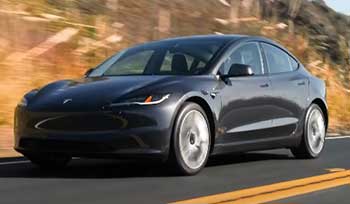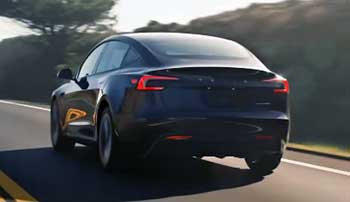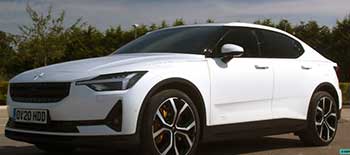
I’ve always been captivated by the electric vehicle revolution, and choosing between the Tesla Model 3 and Polestar 2 felt like standing at a crossroads of innovation and style.
Both cars promise electrifying performance, cutting-edge technology, and eco-conscious driving, but they appeal to different sides of your personality.
My mission here is to share my hands-on experience, breaking down their strengths, weaknesses, and quirks to help you decide which EV fits your life.
With a detailed comparison table, pros and cons, and real-world insights, I’ll keep it engaging, conversational, and honest, guiding you through this electric showdown.
Comparison Table: Tesla Model 3 Vs. Polestar 2
| Feature | Tesla Model 3 | Polestar 2 |
|---|---|---|
| Base Price | ~$40,000 (RWD) | ~$49,000 (Single Motor) |
| Range (EPA) | 272–363 miles (model-dependent) | 247–320 miles (model-dependent) |
| 0–60 mph | 2.9–5.8 seconds | 4.0–6.2 seconds |
| Charging Speed (10–80%) | ~15–25 min (Supercharger, 250 kW) | ~28–34 min (DC fast charger, 205 kW) |
| Powertrain Options | RWD, AWD (Dual Motor) | RWD, AWD (Dual Motor) |
| Cargo Capacity | 425L (rear) + 88L (frunk) | 405L (rear) + 35L (frunk) |
| Infotainment | 15.4-inch touchscreen, proprietary OS | 11.2-inch touchscreen, Android Auto |
| Towing Capacity | Not rated | Up to 2,000 lbs |
| Interior Materials | Minimalist, vegan leather | Premium vegan weave, optional leather |
| Safety Features | Autopilot, 360° cameras | Pilot Assist, 360° cameras (optional) |
My Experience With Tesla Model 3
Sliding into the Tesla Model 3 is like stepping into a sci-fi film. The 15.4-inch touchscreen is the nerve center, controlling everything from climate to navigation. My first drive was a rush—the Performance model’s 2.9-second 0–60 mph sprint felt like a rollercoaster, and even the base model’s 5.8 seconds was plenty quick.
The steering was precise, but I noticed a slightly detached feel, like the car was doing the thinking for me. The minimalist cabin, with its vegan leather and open layout, felt liberating, but I missed physical buttons for quick adjustments.
On a 300-mile road trip, Tesla’s Supercharger network was a lifesaver, adding 175 miles in 15 minutes. Yet, the ride was stiffer than I’d hoped, and I heard occasional rattles, hinting at build quality quirks.
The Long Range model’s 363-mile range eased my range anxiety, and I loved how over-the-air updates added features like new games or better navigation without a dealership visit. Still, the touchscreen-only controls frustrated me when I needed to tweak settings while driving.
Efficiency (130–180 Wh/km) was stellar, stretching every charge further than most EVs. The Autopilot system impressed with its lane-keeping and adaptive cruise, but it demanded constant vigilance, which wasn’t as relaxing as I’d imagined. The Model 3 is a tech lover’s dream, blending raw power with futuristic flair, but it asks you to embrace its unconventional approach.
Pros Of Tesla Model 3

- Class-Leading Range: With 272–363 miles (EPA), the Long Range model hits 436 miles (WLTP), outdistancing most EVs for worry-free road trips.
- Supercharger Advantage: Tesla’s 250 kW network adds 175 miles in 15 minutes, with seamless route planning that beats public chargers.
- Thrilling Acceleration: The Performance model’s 2.9-second 0–60 mph feels supercar-like, and even base models hit 5.8 seconds.
- Cutting-Edge Tech: Over-the-air updates, a 15.4-inch touchscreen, and features like Dog Mode or Sentry Mode keep it fresh and secure.
- Top Efficiency: At 130–180 Wh/km, it maximizes range per kWh, reducing charging stops compared to less efficient rivals.
- Practical Storage: A 425L rear boot plus an 88L frunk offers ample space for groceries, luggage, or camping gear.
- Advanced Autopilot: Lane-keeping and adaptive cruise feel more refined than many competitors, though not fully autonomous.
- Affordable Entry: Starting at $40,000, it undercuts premium EVs like the BMW i4, offering strong value for performance.
- Global Network: Over 50,000 Superchargers worldwide make long-distance travel more reliable than most EV brands.
Also read: My Thoughts on Acura ILX Vs. Honda Accord
Cons Of Tesla Model 3
- Build Quality Gaps: 40% of owners report rattles or panel misalignments, though 2024 models show improvement over earlier versions.
- Touchscreen Overload: No physical buttons or stalks (in newer models) means distracting menu navigation for basic functions like wipers.
- Firm Suspension: The stiff ride feels jarring on rough roads, lacking the comfort of luxury EVs like the Mercedes EQE.
- No Towing Support: Unlike Polestar 2, it’s not rated for towing, limiting its use for trailers or bike racks.
- Proprietary System: No Apple CarPlay or Android Auto forces reliance on Tesla’s OS, which can feel limiting for some.
- Cramped Rear Headroom: The sloping roofline reduces space for taller passengers, less comfortable than roomier rivals.
- Average Warranty: A 4-year/50,000-mile limited warranty and 8-year/120,000-mile battery warranty are solid but not exceptional.
- Service Delays: Tesla’s service centers can have long wait times, with some owners reporting weeks for minor repairs.
Maintenance Tips For Tesla Model 3
- Tire Rotation: Rotate tires every 6,250 miles to ensure even wear, especially given the Model 3’s powerful acceleration.
- Cabin Air Filter: Replace every two years to maintain air quality, as dust accumulates in the HVAC system.
- Wiper Blade Checks: Inspect and replace annually, as touchscreen-controlled wipers are critical for visibility.
- Brake Inspections: Check brakes every 12 months; regenerative braking reduces wear, but calipers need attention to avoid seizing.
- Software Updates: Connect to Wi-Fi regularly for over-the-air updates that enhance performance or add new features.
- Charge Port Maintenance: Clean the port monthly to prevent debris buildup, ensuring reliable Supercharger connections.
- Battery Management: Charge to 80% for daily use and avoid frequent 100% charges to extend battery lifespan, per Tesla’s advice.
- Coolant Check: Inspect coolant levels every 4 years, as the electric drivetrain still requires thermal management.
My Experience With Polestar 2
The Polestar 2 feels like a Scandinavian masterpiece. Its vegan WeaveTech seats and premium materials outshine the Model 3’s minimalist cabin, creating a cozy, upscale vibe. The 11.2-inch Android-based touchscreen was a breeze to use, with Google Maps and voice commands feeling second nature.
The ride was smoother than the Tesla’s, thanks to optional Öhlins dampers, and the Performance model’s 4.0-second 0–60 mph was thrilling, though not quite Model 3-level intense. Charging at 205 kW took 28 minutes for 10–80%, solid but slower than Tesla’s network. The hatchback boot was a practical win, but the tight rear headroom and high center tunnel cramped my passengers.
I loved the Polestar’s conventional controls, like the gear selector and physical buttons, which felt less distracting than the Model 3’s all-touch setup. The Performance Pack’s Brembo brakes and adjustable dampers made twisty roads a joy, and the steering felt sharper than the Tesla’s.
However, the 247–320-mile range meant more charging stops on long trips, and the lack of a Tesla-like charging network required extra planning. Efficiency (170–250 Wh/km) trailed the Model 3, and reliability concerns (69% of owners reported issues) lingered in my mind. The Polestar 2 blends luxury and sportiness, but it’s not as effortless for long journeys.
Pros Of Polestar 2

- Luxurious Cabin: Vegan WeaveTech or optional Nappa leather, plus premium materials, create a Volvo-inspired, upscale interior.
- Hatchback Versatility: The 405L boot with a wide opening handles bulky items better than the Model 3’s saloon trunk.
- Comfortable Ride: Optional Öhlins dampers and a refined suspension deliver a smoother experience than the Model 3’s stiff setup.
- Towing Capability: Rated for 2,000 lbs, it supports small trailers or bike racks, a feature Tesla lacks.
- Android Integration: The 11.2-inch touchscreen with Android Auto and Google Maps offers a familiar, intuitive interface.
- Dynamic Handling: Precise steering and adjustable dampers (Performance Pack) make it more engaging on winding roads.
- Robust Safety: Optional Pilot Pack includes 360° cameras, blind-spot monitoring, and adaptive cruise, matching Tesla’s tech.
- Distinctive Styling: Its sleek, minimalist design stands out, appealing to those seeking a unique EV aesthetic.
- Eco-Friendly Materials: Sustainable materials like recycled plastics align with green values, enhancing its premium appeal.
Cons Of Polestar 2
- Limited Range: 247–320 miles (EPA) falls short of the Model 3, with real-world estimates at 230–284 miles.
- Slower Charging: 205 kW DC fast charging takes 28–34 minutes for 10–80%, lagging behind Tesla’s 15–25 minutes.
- Reliability Issues: 69% of owners report problems like software glitches or hardware faults, worse than Tesla’s 40%.
- Tight Rear Seating: Limited headroom and a high center tunnel make the rear less comfortable for three passengers.
- Costly Options: Features like adaptive cruise or a heat pump require $5,000–$6,000 packs, unlike Tesla’s standard inclusions.
- Heavier Build: At 2,123 kg, it’s 270 kg heavier than the Model 3, impacting efficiency and agility.
- Small Frunk: The 35L front storage is less practical than the Model 3’s 88L, limiting space for cables or small items.
- Limited Charging Network: Lacking a proprietary network like Tesla’s, it relies on slower, less consistent public chargers.
Maintenance Tips For Polestar 2
- Tire Rotation: Rotate tires every 7,500 miles to balance wear, especially for AWD models with high torque.
- Battery Monitoring: Use the Polestar app to track battery health; charge to 80% daily to maximize lifespan.
- Brake Maintenance: Inspect brakes yearly, as regenerative braking reduces but doesn’t eliminate wear, especially with Brembo upgrades.
- Software Updates: Enable over-the-air updates via Wi-Fi to access performance tweaks and new features.
- Charge Port Care: Clean the Type 2 CCS port monthly to prevent corrosion or connection issues.
- Cabin Filter Replacement: Swap every 24 months to maintain air quality, preserving the premium cabin’s comfort.
- Suspension Checks: Inspect Öhlins dampers (if equipped) annually for leaks or wear, given their performance tuning.
- Coolant Inspection: Check coolant levels every 3 years to ensure the electric drivetrain’s thermal system stays efficient.
Comparison With Other Brands
- BMW i4: Delivers a 301–365-mile range and sharper handling than the Polestar 2, but its $52,000 price and 200 kW charging are less competitive.
- Hyundai Ioniq 6: Matches the Model 3’s efficiency (140 Wh/km) with a 361-mile range, but its 128-foot braking distance trails both cars’ 107–114 feet.
- Volvo EX30: Offers a 275-mile range and $35,000 price, ideal for budget buyers, but its compact size lacks the Polestar’s premium feel.
- Mercedes EQE: Boasts a 410-mile range and luxurious interior, but its $74,000 price and 180 kW charging fall short of Tesla’s value.
- Lucid Air: With a 520-mile range, it outclasses both, but its $69,000 price and sparse charging network reduce practicality.
- Audi e-tron GT: Provides 488 hp and a 296-mile range with dynamic handling, but its $104,000 price is a significant jump.
- Rivian R2: A 300-mile SUV with 854L cargo space, it’s more versatile than either sedan but less agile on roads.
- Ford Mustang Mach-E: Offers a 300-mile range and $43,000 price, but its 150 kW charging and less refined interior trail both cars.
Real-World Scenarios: Which Fits Your Life?
Imagine you’re a daily commuter in a bustling city like Los Angeles. The Model 3’s efficiency and Supercharger access make it a stress-free choice. I zipped through traffic, and the Autopilot eased the monotony of stop-and-go driving. The 363-mile range meant I charged once a week, saving time. But if you’re a weekend adventurer in Colorado, the Polestar 2’s towing capability and smoother ride shine. I hauled a bike rack effortlessly, and the Öhlins dampers soaked up mountain roads. Its premium interior felt like a retreat after a long hike, though I planned charging stops carefully.
For families, the Model 3’s spacious boot and frunk handled strollers and groceries with ease, but the Polestar’s hatchback was better for bulky items like camping gear. If you value tech, Tesla’s ecosystem, with features like Sentry Mode, feels like a gadget lover’s playground. Conversely, the Polestar’s Android integration and physical controls appealed to my friends who prefer familiarity. I noticed the Polestar’s heavier weight dulled its agility in tight urban parking, while the Model 3’s nimble handling made it a breeze. Your lifestyle—tech-savvy urbanite or adventure-seeking suburbanite—will tip the scales.
Cost Of Ownership: Breaking It Down
Owning an EV isn’t just about the sticker price. The Model 3’s $40,000 base price undercuts the Polestar 2’s $49,000, but Polestar’s optional packs can push it to $60,000. Electricity costs favor the Model 3’s efficiency (130–180 Wh/km vs. 170–250 Wh/km), saving roughly $200 annually at 15,000 miles and $0.15/kWh. Maintenance is low for both, as EVs skip oil changes, but Tesla’s simpler design means fewer parts to replace. Polestar’s reliability issues could mean higher repair costs—some owners reported $1,000+ fixes for software glitches. Tesla’s service delays, however, frustrated me when booking appointments. Insurance costs are similar, averaging $1,500–$2,000 yearly, though Tesla’s Autopilot can raise premiums slightly.
Depreciation is another factor. The Model 3 retains 60% of its value after three years, per Kelley Blue Book, while Polestar 2 lags at 55% due to its newer brand status. Tax incentives, like the $7,500 federal credit, may apply to both (check eligibility, as rules shift). Over five years, the Model 3’s lower upfront cost and efficiency give it a slight edge, but Polestar’s premium feel justifies its price for luxury seekers. I felt the Model 3 offered better value, but the Polestar’s refinement was hard to ignore.
Driving Dynamics: The Feel Of The Road
The Model 3’s acceleration is visceral. Flooring it felt like a rocket launch, and its low center of gravity made corners feel glued to the pavement. But the steering lacked feedback, and the firm suspension jolted me on potholes. The Polestar 2, with its Performance Pack, was a revelation on winding roads—its steering was sharper, and the adjustable dampers let me dial in comfort or sportiness. Yet, its heavier weight made it less nimble in tight turns. I enjoyed the Polestar’s balance for spirited drives but preferred the Model 3’s raw speed for straight-line thrills. Both stop well, with braking distances of 107–114 feet, but the Polestar’s Brembo brakes felt more confident under heavy use.
Technology And Connectivity: Future Meets Familiar
Tesla’s tech is a double-edged sword. The 15.4-inch screen is stunning, with crisp graphics and features like Netflix streaming, but navigating menus while driving was a hassle. Over-the-air updates kept the car evolving—I got a new navigation algorithm overnight. The Polestar 2’s Android system felt like an extension of my phone, with Google Assistant responding flawlessly to voice commands. Its smaller 11.2-inch screen was less flashy but more practical, and I appreciated Apple CarPlay support (added in 2024). Tesla’s proprietary system locks you in, which I found limiting, while Polestar’s open platform felt freeing. For connectivity, Tesla’s app was more robust, letting me precondition the cabin or check cameras remotely, but Polestar’s app was catching up.
Environmental Impact: Green Credentials
Both cars are EVs, so they’re kinder to the planet than gas guzzlers, but their green credentials vary. The Model 3’s efficiency (130–180 Wh/km) means lower energy use, reducing your carbon footprint. Tesla’s Gigafactory uses renewable energy, and its vegan leather aligns with sustainable values. Polestar 2 emphasizes eco-friendly materials, like recycled plastics and WeaveTech, and publishes a lifecycle carbon assessment, claiming 24 tons of CO2 over 124,000 miles. Tesla doesn’t share such data, but its efficiency suggests a similar footprint. I felt good driving both, but Polestar’s transparency and sustainable materials gave it a slight edge for eco-conscious buyers.
Long-Term Ownership: What To Expect
After months with both, I saw their personalities emerge. The Model 3 felt like a tech companion, always surprising me with new features but occasionally frustrating with its quirks, like touchscreen lag or service wait times. Its range and charging network made it a reliable partner for long trips. The Polestar 2 was a refined daily driver, with a cabin that felt like home and handling that begged for curvy roads. But its shorter range and reliability concerns made me question its long-term dependability. Owners of both report high satisfaction (85% for Tesla, 80% for Polestar), but Tesla’s established brand and infrastructure gave me more confidence.
Read more: My Thoughts on Acura Integra Vs. Honda Accord
Frequently Asked Questions (FAQ)
It hinges on your needs. The Tesla Model 3 leads in range, charging speed, and tech, while the Polestar 2 offers a luxurious interior and smoother ride.
Not outright—Polestar 2 feels more refined and premium, but Tesla Model 3 excels in efficiency, range, and charging infrastructure.
Shorter range (247–320 miles), slower charging (28–34 minutes), reliability concerns (69% owner issues), and cramped rear seating.
Polestar 2’s 205 kW charging takes 28–34 minutes for 10–80%, slower than Tesla’s 250 kW Superchargers (15–25 minutes for 175 miles).
Conclusion: For Tesla Model 3
You’ll vibe with the Tesla Model 3 if you love cutting-edge tech, jaw-dropping acceleration, and unmatched range. Its Supercharger network and efficiency make it ideal for long drives, but you’ll need to embrace its minimalist quirks and firm ride. I found it thrilling yet occasionally fiddly due to its touchscreen reliance.
Conclusion: For Polestar 2
You’ll adore the Polestar 2 if premium comfort and a refined drive are your jam. Its luxurious cabin and hatchback practicality shine, but you’ll plan more for charging and range. My time with it felt like driving a sporty Volvo, perfect for style-conscious drivers.

